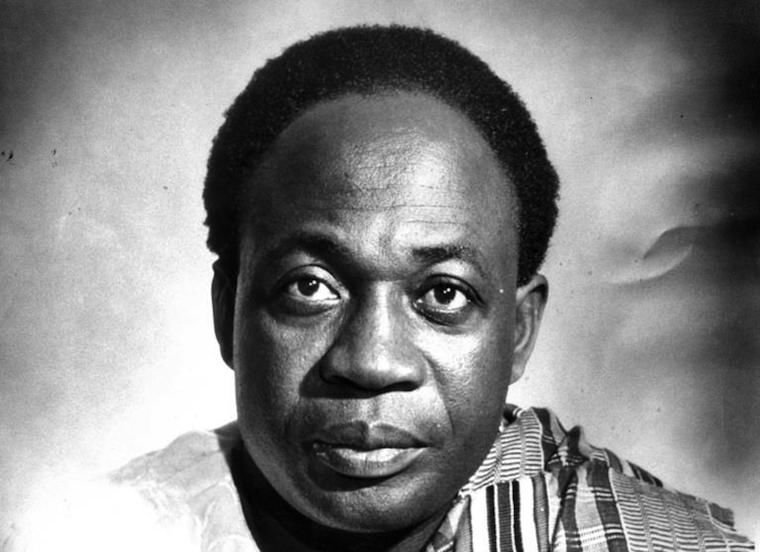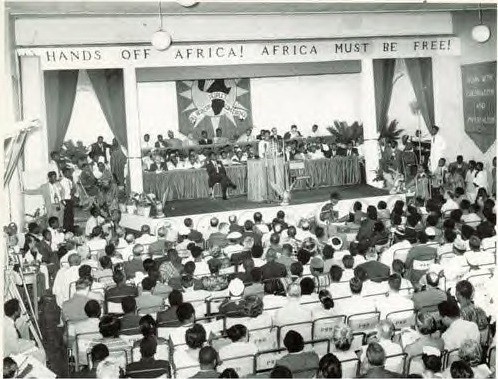Kwame Nkrumah, Prime Minister of Ghana, addressing the first All Africa People’s Conference (AAPC) in Accra, Ghana, December 5-13, 1958. Behind Nkrumah in a chair is Tom Mboya (Kenya), who served as chair of the AAPC.
The idea of Pan-Africanism had been developed by intellectuals of African descent outside of Africa, mainly in the United States where it “represented a reaction against oppression of blacks and the racial doctrines that marked the era of abolitionism” (Olisanwuche Esedebe, 1994: 8). It eventually was adopted by independence movements in Africa. P. Olisanwuche Esedebe defines Pan-Africanism as “a political and cultural phenomenon that regards Africa, Africans, and African descendants abroad as a unit. It seeks to regenerate and unify Africa and promote a feeling of oneness among the people of the African world. It glorifies the African past and inculcates pride in African values” (Ibid.: 5).
For the formation of a movement it took another century until the Chicago Congress on Africa in 1893 where Africans as well as people of African descent but also some white Americans and Europeans gathered. It was commented by the Chicago Newspaper Advance as “unquestionably one of the most notable convocations of recent years in any country” (Ibid.: 40). More commonly known as the beginning of the Pan-African Movement is the Pan-African Congress in Westminster in 1900, where W.E.B Du Bois played a leading role and appealed in his speech to the “nations of the world” to respect the integrity and independence of the already independent “Negro States”, and called for the “black subjects of all nations to take courage, strive ceaselessly and fight bravely, that they may prove to the world their incontestable right to be counted among the great brotherhood of mankind.” The overall message was the call for the establishment of an African identity and solidarity, the return of African people all over the world to their home continent, solidarity with and within Africa, the end of colonialism and the independence of all of Africa. It was directed at all people of African descent, as well as all nations to respect their equality, which was as relevant in the metropoles as in the colonies. This notion of Pan-Africanism played a significant role for independence movements and fighters like Lumumba in shaping an African future. Pan-Africanism was hereby understood both as an act of unifying the countries of Africa politically and of creating a counterweight to the Western imperialists, as well as a feeling of cultural belonging and solidarity that extended to the African diaspora. The liberation of Africa from the colonial yoke and the fight for equality in the metropole by the Civil rights Movement went hand in hand.
As Cemil Aydin points out in his study of Pan-Nationalism, “the history of almost all nationalist movements, especially in the colonized world, was intertwined with a pan-nationalist discourse, vision, or project” (Aydin, 2013: 671). Pan-Africanism is such a pan-nationalism, a “‘politico-cultural movement seeking to enhance and promote the solidarity of peoples bound together by common or kindred language, cultural similarities, the same historical traditions, and/or geographical proximity” (Ibid.: 674). However, for Pan-Africanism this definition only partly applies. Accounting for a common or kindred language or cultural similarities as a binding factor would be simplifying cultural differences. Historical traditions and geographical proximity however come closer in describing the connecting elements underlying the Pan-African movement, and mainly it was the shared experience of European colonialism and subjugation. Nevertheless, language also played a unifying role in a sense, as some of the Francophone countries of Africa kept closer bonds to each other than to the rest of the continent.
From the 1940s onwards, independence movements in the colonies increasingly included Pan-Africanism as part of their anti-colonial struggle. By then, the movement had undergone several ups and downs, had held various conferences and had formed and dissolved numerous associations. At the fifth Pan-African Congress in Manchester in 1945, “the leadership was handed from the diaspora community to the actual leaders of new nationalism on the African continent such as Kwame Nkrumah” (Aydin, 2013: 626). At the Manchester Congress for the first time the African participants constituted a large number and it marked a change in strategy of the Pan-African Movement. It moved its focus from being a predominantly intellectual movement to winning popular support and joining forces with the masses in the campaign for political emancipation (O.E., 1994: 145). While the Pan-African movement until then was mainly dominated and brought forward by intellectuals of the African diaspora, an increasing number of young, politically engaged Africans were ready to implement these ideas in their home continent and to be “hand[ed] over the Pan-African torch from the ‘Diaspora’ to the Africans” (Ibid.: 6).

Kwame Nkrumah was the leader of the independence movement in Ghana and first president after independence. He strongly supported the idea that nationalism and Pan-Africanism were inextricably linked and that the liberation and unification of the whole continent was just as important as the independence of his own nation. Ghana was one of the first African countries to declare independence from the British Empire in 1957. In his independence speech on 6th march in Accra, Nkrumah emphasised that Ghana’s “independence is meaningless unless it is linked up with the total liberation of Africa.” This shows his commitment to continue fighting for a free Africa and that his dedication didn’t end at the doorstep of his nation. This was grounded in the belief in African solidarity, but also in the realization that only if all of Africa was free, their own freedom could be maintained. As P. Olisanwuche Esedebe concludes, “the emancipation of Ghana served to pave the way for closer cooperation among African peoples. Between 1958 and 1963 African leaders began to meet at frequent intervals. Some of these meetings were conferences of states already independent. Others were nongovernmental gatherings of leaders of independence movements and trade unions” (O.E., 1994: 160). Pan-Africanism therefore was integral to many further anti-colonial struggles and decolonization processes.
It was in this optimistic moment of solidarity, in this “new chapter in the history of Africa, and the relations between Africa and Europe” (Legum quoted in O.E., 1994: 167), that Patrice Lumumba declared the Congo’s independence from Belgium on June 30, 1960. Two years earlier, in December 1958, he had participated in the All-African People’s Conference in Accra which was convened by Kwame Nkrumah and got heavily inspired by Pan-African ideas and their political implementation and believed “the Congo’s independence [was] a decisive step towards the liberation of the whole African continent” (Ibid.). At the conference, Lumumba stated in his speech:
This historical conference, which puts us in contact with experienced political figures from all the African countries and from all over the world, reveals one thing to us: despite the boundaries that separate us, despite our ethnic differences, we have the same awareness, the same soul plunged day and night in anguish, the same anxious desire to make this African continent a free and happy continent that has rid itself of unrest and of fear and of any sort of colonialist domination.
In the years following, African unity continued to be a pressing issue for Lumumba. One of the reasons was the growing conflict between the US and the Soviet Union. In his speech at the opening of the All-African Conference in Leopoldville on August 25, 1960 he expressed that not only through Non-Alignment but rather through the establishment of a “Pan-African bloc” following the “policy of positive neutralism” a counterweight to the global powers could be created and imperialist aspirations kept out of the African continent.
However, already in its early attempts of implementation Pan-Africanism became a contested idea and was regarded as too radical by many. According to Sapin Makengele this hasn’t changed much until today and the idea of Pan-Africanism as a continental political unity, as Nkrumah and Lumumba have envisioned it, seems even more unlikely to become a political reality. Sapin Makengele states that the idea of Pan-Africanism nowadays is associated with rebellious ideas by African leaders. Pan-Africanists, many of them living in the diaspora, are considered “groups of rebels, who want to destabilise Africa”, because they call for a united Africa and therefore challenge the status quo and the influence of the ruling class. According to Sapin, “to be a Pan-Africanist is to be someone who loves his continent, someone who wants change, who wants to see things evolve.” And for him, “nowadays, the idea of Pan-Africanism is a very good thing […] and it must continue.” For those in power, which he describes as “African capitalists”, change is not desirable, as they fear a loss of wealth and influence. Sapin’s describes the OAU as a “meeting of African scramblers” (une réunion des embrouilleurs africains). This evokes resemblance to the notion of the “Scramble for Africa” – the division of the African continent between the European imperial powers in 1884. We could interpret this as a link to the idea that just as the European imperialists have divided Africa for its riches in the 19th century, African politicians nowadays are acting out of greed for profit to enrich themselves and their Western partners, with no regards to the interests of the population.
Images:
Header http://africanactivist.msu.edu/image.php?objectid=32-131-1DE, Southern Africa Committee photo archive
(1) https://www.blackpast.org/global-african-history/nkrumah-kwame-1909-1972/


